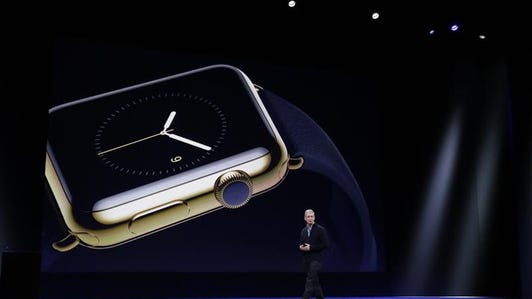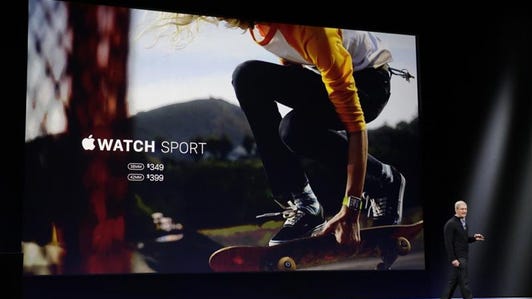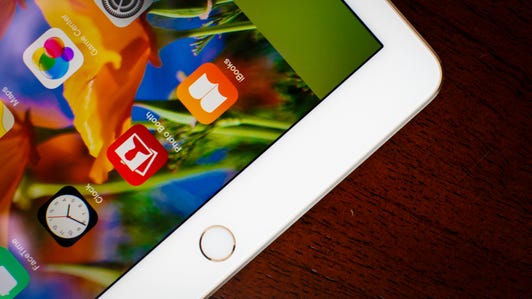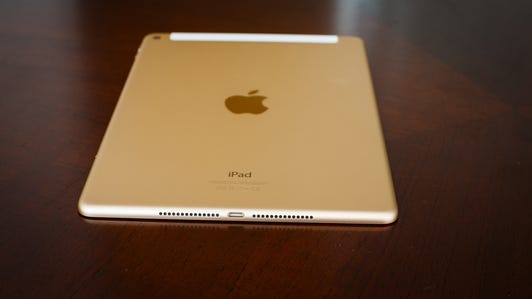
James Martin/CNET
Apple reported its biggest quarter ever on Tuesday, and CEO Tim Cook had a lot to be happy about during a call with analysts.
Apple’s fiscal first quarter, which ended December 27, was an absolute blowout. Its earnings, revenue and margins smashed Wall Street expectations, and it posted its highest quarter ever for Mac and App Store revenue. The iPhone far and away drove the results, with Apple selling more smartphones than ever before.
Analysts published notes that called the quarter “stunning,” “outstanding” and “a monster.” One simply said, “Wow!”
It “seems like the whole world wants an iPhone,” UBS analyst Steven Milunovich noted.
Here’s what Cook had to say about Apple’s fiscal first quarter.
See also
- iPhone’s double-edged sword: Big sales, big risk for Apple
- Apple rings up big holiday sales thanks to larger-screen iPhone 6
- Apple beats world record in quarterly profits
- Apple Watch to start shipping in April
It’s all about iPhone
iPhone has been Apple’s top seller for years, but it became an even bigger part of the company’s revenue in the first quarter. About 69 percent of Apple’s $74.6 billion in sales came from its smartphone, far more than its typical level of closer to 50 percent.
The huge bump in iPhone sales came from the company’s newest products, the 4.7-inch iPhone 6 and the 5.5-inch 6 Plus. Consumers have scooped up the devices — which sport bigger screens than 2013’s 4-inch iPhone 5S — in record numbers. Unit shipments for the smartphone jumped 46 percent to 74.5 million from the same quarter a year ago, its former record high. At the same time, revenue soared 57 percent to $51.2 billion.
Apple’s huge reliance on one product opens the company up to risk, but for now, Apple is happy to benefit from huge demand for the device. Cook said that iPhone sales in emerging markets, such as Brazil and Mainland China were “absolutely stunning,” more than doubling year-over-year, which is three times to four times what those markets had been doing, according to IDC.
“Demand for iPhone has been staggering, shattering our high expectation, with sales of over 74 million units, driven by the unprecedented popularity of iPhone 6 and iPhone 6 Plus. This volume is hard to comprehend. On average we sold over 34,000 iPhones every hour, 24 hours a day, every day of the quarter. …
There is clearly a geographic difference where some geos would skew much higher on their preference to iPhone 6 Plus than other geos. And so it’s something that is not consistent around the world. But both did incredibly well, and we’re really proud of them, along with the iPhone 5S and 5C as well, which continues to be in the lineup. …
I would point out that only a small fraction of the installed base has upgraded. And so there is a lot more people within the installed base. But I would also point out that we had the highest number of customers new to iPhone last quarter than in any prior launch. And also that the current iPhone lineup experienced the highest Android switcher rate in any of the last three launches in the three previous years. We didn’t look back to the other years, so I don’t know about those.
And so we see that we’re appealing to new customers, both new to smartphone and new to iPhone and people switching. … And so we enter the quarter with quite a bit of momentum.”
Apple Watch will start shipping in April
Apple Watch keeps up with the times (pictures)






When Apple announced its first wearable, the Apple Watch, in September, it didn’t give any specifics about when the device would ship, only saying “early 2015.” Cook on Tuesday did something unexpected: He gave information about a product during an earnings call, not during a splashy press event.
The Apple Watch is the first major new product category for the company since the “magical” iPad in 2010. It’s also the first new push by the company under Cook’s leadership. Cook had promised for more than a year that Apple would introduce
in 2014 and enter beyond its wildly successful smartphones, tablets and computers. The Apple Watch and the new Apple Pay mobile-payments service fulfill that vow.
“Development for Apple Watch is right on schedule, and we expect to begin shipping in April. Developers are hard at work on apps, notifications and information summaries that we call Glances, all designed specifically for the Watch’s user interface. The creativity and software innovation going on around Apple Watch is incredibly exciting, and we can’t wait for our customers to experience them when Apple Watch becomes available. …
My expectations are very high on it. I’m using it every day and love it, and I can’t live without it. So, I see that we’re making great progress on the development of it. The number of developers that are writing apps for it are impressive, and we’re seeing some incredible innovation coming out there. And just to clarify, what we had been saying was early 2015, and we sort of look at the year and think of early as the first four months, mid is the next four months and late is the final four months. And so, to us it’s sort of within the range and it’s basically when we thought. … But most importantly we’re going to be thrilled to start shipping it, because we got a lot of customers that are wanting to get one.”
China’s still not the No. 1 iPhone market, but it’s close
Related articles
- Apple notches huge sales in China during Q1
- Apple shipped its billionth iOS device in November
- Tim Cook: 2015 will be the year of Apple Pay
- CNET’s first take on Apple Watch
Emerging markets represent a critical source of growth for everyone, from giants such as Apple and Samsung to newcomers like Xiaomi. China became the world’s largest smartphone market in 2011 and now is home to almost 520 million smartphone users. Apple has been gaining market share in the country, following deals with major carriers, including China Mobile, the world’s largest wireless provider with more than 800 million subscribers.
Research firm Canalys on Tuesday said Apple became the biggest smartphone vendor by shipped units in China during the December quarter. Apple gained the title for the first time in its 38-year history, the firm said, surpassing Chinese vendor Xiaomi at No. 2 and South Korean giant Samsung at No. 3. Huawei nabbed the fourth-highest market share during the December quarter. A year earlier, Apple held the No. 6 position in China, Canalys said. Its highest position in the previous seven quarters was No. 4 in the first calendar quarter of 2014.
Other analysts believed China would surpass the US as the iPhone’s biggest market, but that didn’t happen in the first quarter. Still, Apple generated $16.1 billion in revenue in Greater China in the fiscal first quarter, up 70 percent from the same period a year ago. In mainland China, sales more than doubled from the previous year. Greater China — which includes mainland China, Hong Kong and Taiwan — represented 22 percent of Apple’s total sales during the quarter ended December 27, and it was Apple’s second-biggest iPhone market after the US.
“The local competition was obviously there this quarter and has been there for many quarters before. And so the local competition is not new. I think we did really well there. I’m very proud of how we’re doing. I was there right after the launch in October, and the excitement around the iPhone 6, iPhone 6 Plus were absolutely phenomenal. And you can see that in the results with Mainland China being up 100 percent year-on-year, despite not having a full quarter of sales since we launched in the second half of October.
You can tell by that that we’re a big believer in China. We’re looking at our investment. We’re growing the number of stores. We’ll hit 20 soon and we’re doubling that by mid-2016. … We’re also growing the channel there. Our online store has expanded to over 350 cities now, and, in fact, our online revenues in China last quarter were more than the sum of the previous five years. And so it’s an incredible market.”
iPad could struggle for at least the next couple quarters
iPad remained the weak spot in Apple’s results. Tablet unit sales dropped 18 percent to 21.4 million, largely in line with analysts’ predictions. The iPad’s share of the tablet market has dwindled as more low-cost Android tablets have flooded the market. Also, tablet sales in general are down, as more people are opting for big-screened smartphones and choosing to hold onto their existing tablets much longer.
iPad Air 2: Up close and personal with the latest iPad (pictures)






Cook has long called iPad’s weakness in the market a “speed bump,” and on Tuesday he reiterated the tablet has strong opportunities in the long term — but may struggle for the next couple quarters. He said he doesn’t see any “miraculous changes” for the iPad when measured in 90-day clips or in year-over-year. What has his attention is the first-time buyer rate.
“I see that the first-time buyer rates are very high. … By very high, I mean that if you look in some of the developed markets like the US, Japan, the UK, you would find that 50 percent of the people are buying an iPad for the first time. If you look in China, it’s over 70 percent. And so, when you have that kind of first-time buyer rates, you don’t have a saturated market.
When I look at the customer satisfaction on iPad, it’s literally off the charts, in some cases a 100 percent, which is unheard of in surveys to get these kind of customer satisfaction ratings. When I look at the usage, the usage is six times our nearest competitor. The usage defined as measured in web browsing is like 71 percent of total tablets. … Also the commerce taking place across the iPad is enormous. Essentially, over 80 percent of the commerce on tablets is taking place on iPad. And so when I back up and look at all of these — and I believe that over the long arc of time that the iPad is a great business — I also have visibility obviously of what’s in the pipeline and feel very, very good about that. That said, I’m not projecting — to be clear with everyone — I’m not projecting something very different next quarter or the next. I’m thinking over the long run.
In terms of what I think is going on, I think … the upgrade cycle is longer. It’s longer than an iPhone, probably between an iPhone and a PC. We haven’t been in the business long enough to say that with certainty, but that’s what we think. There is probably some level of cannibalization that’s going on with the Mac on one side and the phone on the other. And so you probably have a little bit of that that is shaking out. How much? Very hard to tell on the early going, particularly since we just shipped the new phones a few months ago.”
Apple will “change the way people work”
One thing Apple is counting on to boost iPad sales is its partnership with IBM. The two companies reached a deal in July for IBM to help push Apple devices and iOS apps to businesses and optimize its cloud-computing services — such as device management, security and analytics — for iOS. The two companies have already introduced the first crop of apps for the airlines, telecommunications, insurance, banking and government industries.
“We’re also making great progress in our partnership with IBM and our collaboration is winning over new customers. In December, we delivered the first 10 MobileFirst for iOS apps for banking, retail, insurance, financial services, telecommunications, governments and airlines, making iPhone and iPad even more productive for enterprises. … Another 12 apps will be released this quarter, including three new industries — health care, energy and utilities — and industrial products. This will bring us to a total of 22 apps, and we’re on track to have over 100 by the end of 2015.
In just over a month, more than a dozen enterprise customers have signed on as foundation clients to transform their companies with iPhone, iPad and IBM MobileFirst solutions, including Miami Dade County, the seventh-largest county in the United States by population, and American Eagle Outfitters, which operates more than 1,000 retail stores and ships to over 80 countries worldwide. And the list of new customers is expanding rapidly. IBM is engaged with more than 130 additional companies looking to empower their employees with MobileFirst for iOS solutions, and the list keeps growing. We couldn’t be more pleased with this partnership. …
If you look at the Fortune 500 as an example, we’re in essentially all of the Fortune 500 companies. So the issue is not that, and it’s not a market share number, because our market share is extremely high. The issue is that enterprises, generally speaking, are only deploying iPads to a small percentage of their workforce. And so the real opportunity is to bring mobility into the enterprises and change how people work. In order to do that, you obviously need apps that are written to specific jobs, not just apps that are general productivity apps, like work processors and spreadsheets and presentation tools, etc.”
2015 is the “year of Apple Pay”
Apple unveiled Apple Pay at the launch of the iPhone 6 and iPhone 6 Plus in September, and, like its competitors, it wants to make a digital replacement for the wallet. Like Google Wallet and the wireless carriers’ group called Softcard, Apple Pay works by letting a user simply tap an iPhone to a payment terminal and then touch the phone’s fingerprint sensor to authorize a purchase. iPhone users also can pay for items in apps and online with a finger touch.


Now playing:
Watch this:
Inside Scoop: Apple says Watch will ship in April, reports…
2:27
Even though people have been able to purchase digital goods, like ringtones, through text messages for years, nothing has been able to convince shoppers to ditch their traditional wallets. Apple thinks Apple Pay, which went live in October with about 500 financial-institution partners and 220,000 merchants, will be different.
“Today about 750 banks and credit unions have signed on to bring Apple Pay to their customers, and in just three months after launch, Apple Pay makes up more than $2 out of $3 spent on purchases using contactless payment across the three major US card networks.
In merchants who already accept Apple Pay, the rates are even higher. Panera Bread tells us Apple Pay represents nearly 80 percent of their mobile payment transactions, and since the launch of Apple Pay, Whole Foods Market has seen mobile payments increase by more than 400 percent. You can use Apple Pay up and down mainstream, to pick up a prescription … get office or school supplies … and shop for groceries at national and regional stores from coast to coast.
More merchants are excited to bring Apple Pay to their customers, and adoption is strong. Just today USA Technologies announced they made Apple Pay available at about 200,000 places where everyday payments happen, including vending machines and businesses, airports and schools, commercial laundry machines and colleges, universities and laundermats and parking meters and payment kiosks in lots across the country. Point-of-sale suppliers tell us they are seeing unprecedented demand from merchants. …
On Apple Pay, both the contactless payment and the app are important. I think they are both huge opportunities. I think they’ll play out differently in different geographic regions as to which one is larger than the other and … the mix of those things will change over time as more and more commerce flows across apps and so forth. …
There’s tons of things on our road map of adding functionality to it. We’re obviously — we’re just in the US right now and so there’s tons of countries to go to … and, of course, we still have a lot of merchants left in the US.
But I have to tell you that given that we’ve launched in October, I’m actually unbelievably shocked, positively shocked, at how many merchants were able to implement Apple Pay in the heart of their holiday season, because generally most people sort of lock down and don’t do very much.”
Apple has sold a lot of Apple TVs
For something that started out as a hobby, Apple TV sure has sold well. Apple hasn’t updated its $99 Apple TV’s hardware since the third-generation device launched in March 2012, but millions of customers have continued to buy it. Apple has hinted for quite some time that it’s working a more complete, over-the-top video-streaming service, but there are no signs such a product is close to ready.
Cook said Apple has sold 25 million Apple TVs, and it’s a product that the company will “continue to look at and work on.”
Best iPhone 6 cases and iPhone 6S cases









